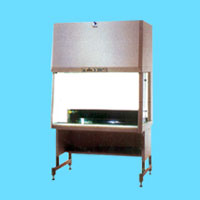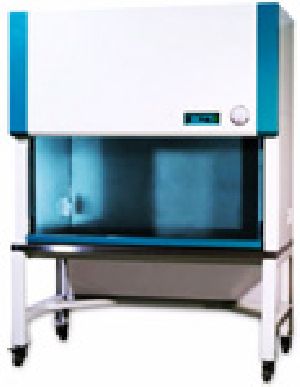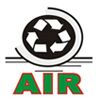
Bio Safety Cabinet
Get Price Quote
1 Piece (MOQ)
We are manufacturers of bio safety cabinets class 100 and class 10000 in India since 2005. Our bio safety cabinets are widely used for day to day clean room activities involving high risk pathogens, etiological agents, non volatile radio nuclides and limited degree of low toxic chemicals for various applications in research labs of all the branches of medical, agriculture, basic and applied science.We specialize in both standard and customized models of bio safety cabinets specially designed to meet the challenging demands of various scientists for individual and specialized research applications. Over a short period of time Labard brand have been established as reliable exporters of bio safety cabinets in India.Apart from the exports, we are also renowned suppliers of bio safety cabinets in India. We are catering to the variety of customers ranging from defense installations, research laboratories, educational institutes and various R & D laboratories of leading national and multinational companies.Features : Ergonomic Design Versatile Usage Low Noise And Vibration Levels Conforms to US Federal Standard 209 B Calibration And Protocol Documentation

flameproof enclosures
Get Price Quote
We are reckoned for manufacturing, supplying and exporting an assortment of Flameproof Enclosures that are tailor made to suit the variegated clients’ requirements. The Flameproof Enclosures are functional as a splice box or pull box, and for enclosing equipment and control devices, relays, contactors etc. The Flameproof Enclosures offered by us are made in synchronization with predefined industry norms. Further, we quote a nominal price and ensure to timely deliver the orders in India and abroad.
Best Deals from Flameproof Enclosure

Atex Flameproof Instrument Enclosure
Get Price Quote
We bring forth top-notch quality Atex Flameproof Instrument Enclosure. Available in different specifications, our Atex Flameproof Instrument Enclosure is ideal for application in glass window enclosure, instrument indicator box and light fixtures. We are backed with modern tools and technology for designing this enclosure with utmost precision. Our skilled experts utilize only quality approved base material for making Atex Flameproof Instrument Enclosures, that too in sync with the set industry standards. Further, these enclosures are quality tested and approved by the authorities assuring high efficiency and durability. Description : Gas Group : I / IIA /IIB Zone Protection : Zone 1 & Zone 2 IP Protection : IP66 Sizes : 250mmx145mm, 62.5mm max dia. MOC : Aluminium Alloy (LM6). Applications : Glass window enclosure Instrument indicator box Light Fixture

Biological Safety Cabinet
Get Price Quote
We offer class ii biological safety cabinet that is preferred for product, personnel and environmental protection. Our biological safety cabinet efficiently handles general microbiological work with agents assigned to bio safety levels 1, 2 or 3. A number of hospitals, clinical research, life science and pharmaceutical laboratories praise our biological safety cabinet for its efficacy and robust construction. these units are comes with motorised sliding shattered proof glass view screen, base stand, removable work tray, supply filter and hepa filters. These class ii biological safety cabinets can be either exhausted back into the room or outside the room. special features large front panel graphical display and user friendly control panel. 10â° slanted view screen provides highly visible and easily accessible area. Work area is surrounded by negative pressure , double-wall plenums for superior protection. Sturdy constriction of cabinet protects from air leakage from the working zone.

biohazard safety cabinet
Get Price Quote
The Bio Hazard Safety Cabinet is characterized by a very high degree of safety for the user and the product. It is equipped with high quality HEPA filters. The HEPA Filter has the same dimensions as the table top. This ensures a unidirectional turbulence free air flow in the working chamber, and optimum product protection. The filters are constructed using aluminum frames and one-piece gasket. Bio Hazard Safety Cabinet is specially designed for applications like isolation and identification of plant I human pathogens, virology, tissue culture, sterility testing and recombinant DNA research. We are one of the leading Manufacturers and Suppliers of Biohazard Safety Cabinet from Maharashtra, India. Features : Safety Level I, II and III as per BSEN StandardClass 100 working conditionNoise level between 60-70 dbOptimum illuminationU.V. lightsExternal exhaust for the laboratory (Optional)

Biological Safety Cabinet
Get Price Quote
Innovation is our forte and in order to facilitate clients with best in class products, we come up with high performing Biological Safety Cabinet. These products are made with precision under the guidance of sedulous professionals and advanced techniques. Furthermore, our professionals test each cabinet on strict guidelines so as to be sure of its perfect design and flawlessness. Features : » Rugged construction» Provide safe working are to user» High efficiency

Bio Safety Cabinets
Get Price Quote
Biological Safety Cabinets are partly recirculating laminar airflow enclosures with high efficiency particulate air (HEPA) filtration of exhaust air and an air barrier at the work opening. HEPA-filtered vertical laminar airflow which is recirculated in the work zone creates an ultra-clean work environment for product protection. An air barrier between the operator and the work zone is maintained by a flow of room air into a full width grille in the work opening. The barrier air mixes with the laminar flow air in a sump underneath the work surface, and is exhausted to the outside environment via a HEPA filter and an optional virus burn-out. All positive pressure zones and filter seals are surrounded by negative pressure zones, so as to contain potentially hazardous aerosols.

Bio Safety Cabinet
Get Price Quote
We manufacture Bio Safety Cabinets and glove boxes as per international standards. We have also initiated R & D work on isolators and within a short span of time we will launch the same. Bio Safety Cabinet in all classes ie Class I, Class II A, Class II B1, Class II B2, Class II B3 and Class III. Cabinets are manufactured in various materials such as Stainless Steel, etc. We recommend Stainless Steel due to anti corrosive property - minimum chances of fungal / bacterial growth - easy to clean Various components viz. HEPA filters, Bag-in and Bag-out arrangements, longer life luminaries fittings etc. are in built in the Bio Safety Cabinet Validation of Bio Safety Cabinet.

Biological Safety Cabinet
Get Price Quote
Our company is bracketed with the leading Manufacturers, Exporters and Suppliers of Biological Safety Cabinet from Maharashtra, India. Biological Safety Cabinet is precisely designed in standard as well as customized specifications by the proficient team of experts. This safety cabinet meets performance criteria laid down by in NSF 49. Our Biological Safety Cabinet is efficient in handling specific risk group 3 pathogen in laboratories. This safety cabinet ensures adequate protection to product and environment. We offer Biological Safety Cabinet at competitive prices.

Flameproof Instrument Enclosure
Get Price Quote
Shree Flameproof Industries Manufacturer, Exporter and Supplier of Flameproof Instrument Enclosure. Owing to our contemporary fabrication facilities and a competent team of diligent personnel, we design all design of Flameproof Instrument Enclosure in varied specifications. These panels are quality tested and approved by the authorities. High efficiency, low maintenance, easy operation and optimum durability are some of the prime features of our Flameproof Instrument Enclosure.

Biological Safety Cabinet
Get Price Quote
This Class II Biological Safety Cabinet is suitable for product, personnel, and environmental protection in, clinical research centers and pharmaceutical laboratories. Biological Safety Cabinet is ensures bio safety levels 1, 2, or 3. Biological Safety Cabinet comes with motorized sliding shattered proof glass view screen, base stand, removable work tray, supply filter and HEPA filters. Biological Safety Cabinet can be either exhausted back into the room or outside the room.Special Features : Large front panel graphical display and user-friendly control panel 10o slanted view screen provides highly visible and easily accessible area. Work area is surrounded by negative pressure, double-wall plenums for superior protection. Sturdy constriction of cabinet protects from air leakage from the working zone.

Ex Enclosures
Get Price Quote

FLAMEPROOF / WEATHERPROOF CIMFR INSTRUMENT ENCLOSURE
35,000 - 70,000 Per PIECE
FLAMEPROOF / WEATHERPROOF CIMFR INSTRUMENT ENCLOSURE

Biological Safety Cabinet
Get Price Quote
When properly maintained and used in conjunction with good laboratory techniques, BSCs provide effective primary containment for work with human pathogens. In containment level 2 facilities, BSCs are used for procedures with the potential to produce infectious aerosols and for high concentrations or large volumes of infectious material. In containment levels 3 and 4, all open vessel activities with infectious materials are conducted in a BSC. Every employee working in a BSC must be trained in its correct use and have a good understanding of the different types of cabinets and how they work.Classes and Characteristics of Biological Safety CabinetsThere are three classes of BSC: Class I, Class II and Class III. Selection of the proper class of BSC requires careful evaluation of the activities to be carried out. Horizontal, clean benches that direct air towards the operator are not biological safety cabinets and must not be used for handling infectious, toxic or sensitizing materials.Class I Cabinets (Figures 1a and 1b)These cabinets have unrecirculated airflow away from the operator that is discharged to the atmosphere after filtration through a HEPA filter. They provide good operator protection but do not protect the material within the cabinet (the product) from contamination.Class II Cabinets (Figures 2-5)Class II cabinets are designed for personnel, product and environmental protection. They are designed for work involving microorganisms in containment levels 2, 3 and 4 laboratories and are divided into two types (A and B) on the basis of construction type, airflow velocities and patterns, and exhaust systems.Within type (A), there are two subtypes, A1 (formerly designated type A) and A2 (formerly designated type B3). Within type (B), there are two subtypes, B1 and B2. Class II cabinets are most commonly used in biomedical research laboratories because of their characteristics.Class II, Type A1 Cabinets (Figure 2)Cabinet air may be recirculated back into the laboratory or ducted out of the building by means of a "thimble" connection (i.e., a small opening around the cabinet exhaust filter housing) whereby the balance of the cabinet is not disturbed by fluctuations in the building exhaust system. The thimble must be designed to allow for proper certification of the cabinet (i.e., provide access to permit scan testing of the HEPA filter).Maintain a minimum average face velocity of 0.38 m/s (75 ft/min).May have positive pressure contaminated ducts and plenums. Are not suitable for work with low levels of volatile toxic chemicals and volatile radionuclides.Class II, Type A2 Cabinets (Figure 3) Cabinet air may be recirculated back into the laboratory or ducted out of the building by means of a "thimble" connection (i.e., a small opening around the cabinet exhaust filter housing) whereby the balance of the cabinet is not disturbed by fluctuations in the building exhaust system. The thimble must be designed to allow for proper certification of the cabinet (i.e., provide access to permit scan testing of the HEPA filter). Maintain a minimum average face velocity of 0.5 m/s (100 ft/min). Have ducts and plenums under negative pressure. Is suitable for work with minute quantities of volatile toxic chemicals and trace amounts of radionuclides. Class II, Type B1 Cabinets (Figure 4) Hard-ducted through a dedicated duct exhausted to the atmosphere after passage through a HEPA filter; contain negative pressure plena. Maintain a minimum average face velocity of 0.5 m/s (100 ft/min). Recirculate 30% of the air within the cabinet. Suitable for work with low levels of volatile toxic chemicals and trace amounts of radionuclides. Class II, Type B2 Cabinets (Figure 5) Does not recirculate air within the cabinet. Maintain a minimum average face velocity of 0.5 m/s (100 ft/min). Hard-ducted through a dedicated duct exhausted to the atmosphere, 100% of cabinet air, after passage through a HEPA filter; contain negative pressure plena. Suitable for work with volatile toxic chemicals and radionuclides. The exhaust canopy must allow for proper BSC certification. An alarm should be provided that is audible at the cabinet to indicate loss of exhaust flow from the building exhaust system. The cabinet internal fan should also be interlocked to shut down when the building exhaust system fan fails, to prevent pressurization of the cabinet.Class III Cabinets (Figure 6)Class III cabinets are totally enclosed and gas-tight with HEPA filtered supply and exhaust air. Work is performed with attached long-sleeved gloves. The cabinet is kept under negative pressure of at least 120 Pa (0.5 in. w.g.), and airflow is maintained by a dedicated exterior exhaust system. Class III cabinets protect the worker and the product. They are designed for work with level 4 pathogens and provide an alternative to the positive-pressure suit made for maximum containment laboratories. Cabinet lines consisting of several Class III cabinets (e.g., for centrifuges, animal cages, incubators, refrigerators) and transfer devices joined together are traditionally custom built. Specific guidance on the unique requirements for constructing, installing, certifying and using Class III cabinet lines can be found elsewhere. The exhaust air is double HEPA filtered or treated by HEPA filter and incineration. Removal of materials from the cabinet must be through a dunk tank, double door autoclave or air-lock pass-through for decontamination. Interlock or protocols must be used for the autoclave and pass-through doors to prevent both doors from being open at the same time. Use of the CabinetFollow these start-up procedures when preparing for work in the BSC : Turn off UV lights if in use and ensure that the sash is in the appropriate position. Turn on fluorescent light and cabinet blower, if off. Check the air intake and exhaust grilles for obstructions. If the cabinet is equipped with an alarm, test the alarm and switch it to the "on" position. Confirm inward airflow by holding a tissue at the middle of the edge of the viewing panel and ensuring that it is drawn in. Disinfect the interior surfaces with a suitable, noncorrosive disinfectant. Assemble all materials required for the procedure and load them into the cabinet; do not obstruct the air grilles; the working surface may be lined with absorbent paper with plastic backing; segregate "clean" items from "contaminated" items. Wait 5 minutes to purge airborne contaminants from the work area. Follow these procedures for working in the cabinet : Don protective clothing and gloves as appropriate. Perform operations as far to the rear of the work area as possible. Avoid movement of materials or excessive movement of hands and arms through the front access opening during use; when you do enter or exit the cabinet, do so from straight on; allow the cabinet to stabilize before resuming work. Keep discarded, contaminated material to the rear of the cabinet; do not discard materials in containers outside of the cabinet. Do not work with open flames inside the cabinet. If there is a spill during use, surface decontaminate all objects in the cabinet; disinfect the working area of the cabinet while it is still in operation (do not turn the cabinet off). Follow these procedures upon completion of the work : Allow the cabinet to run for 5 minutes with no activity. Close or cover open containers before removing them from the cabinet. Surface disinfect objects in contact with contaminated material before removal from the cabinet. Remove contaminated gloves and dispose of them as appropriate; wash hands. Don clean gloves, and ensure that all materials are placed into biohazard bags within the cabinet. Using a suitable non-corrosive disinfectant (e.g., 70% ethanol), disinfect interior surfaces of cabinet; periodically remove the work surface and disinfect the area beneath it (including the catch pan) and wipe the surface of the UV light with disinfectant. Turn off the fluorescent light and cabinet blower when appropriate (some cabinets must be left on at all times; if you are unsure, check with your cabinet certifier, safety officer or building maintenance personnel). Turn on the UV light if appropriate (do not turn on when people are working close by); UV must be tested to ensure that it is emitting a germicidal wavelength (ask your cabinet certifier to perform this test). Unit Description Construction are Stainless Steel Body OR CRCA Powder coated Differential Pressure Gauge Milky White Light Feather Touch Motor Blower Assemblies : 0.5 HP, ~230 V, 1 phase, 50 Hz HAPA Filters (Final Filter) : H13, Efficiency 99.97% down to 0.3µ Prefilters : EU6, Efficiency 95% down to 5µ OPTIONAL ACCESSORISE Stainless steel perforated grille for HEPA Filter Glove ports Filter blocked alarms Stands Hour meter Ultraviolet light Biological Safety Cabinet is with a variety of standard dimensions. Also our booth.

Flameproof Enclosure
Get Price Quote
Flameproof Enclosure, Flameproof Control Panels, Flameproof LED Flood Light

Bio Safety Cabinet
Get Price Quote
Bio Safety Cabinet, Air Sampler, mic anaerobic workstation, Magnetic Stirrer

Bio Safety Cabinet
Get Price Quote
Bio Safety Cabinet, clean room modular system, Clean Room Doors, Hvac system

Bio Safety Cabinets
Get Price Quote
Bio Safety Cabinets, anaerobic workstation, Laboratory Instruments

Bio Safety Cabinet
Get Price Quote
Bio Safety Cabinet, oxygen analyser, Microprocessor Karl Fischer Titrator

FLP Instrument Enclosures
Get Price Quote
FLP Instrument Enclosures, FLP Instrument Panels, FLP Junction Boxes